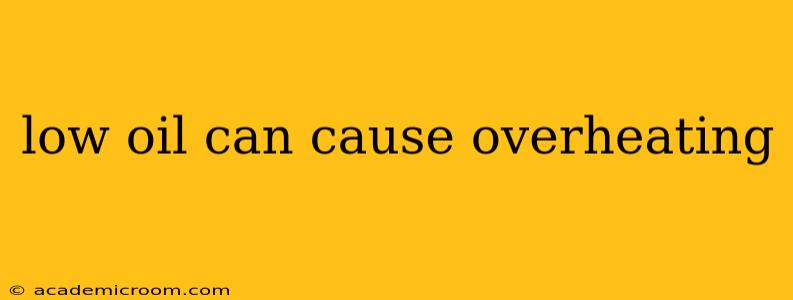Low engine oil levels are a serious problem that can lead to catastrophic engine failure. One of the most immediate and dangerous consequences of low oil is overheating. This isn't just a minor inconvenience; it can cause significant and costly damage to your vehicle's engine. Let's delve into why low oil causes overheating and what you can do to prevent this dangerous situation.
How Does Low Oil Lead to Overheating?
Engine oil serves several crucial functions, but its role in cooling is often overlooked. Oil acts as a lubricant, reducing friction between moving engine parts. This friction generates heat. When there isn't enough oil, this friction increases dramatically, leading to a significant rise in engine temperature. The oil also helps to transfer heat away from critical engine components, like the pistons and cylinder walls. With insufficient oil, this heat transfer process is compromised, causing the engine to overheat.
Think of it like this: oil acts as a coolant, albeit a secondary one. While the coolant system (radiator, water pump, etc.) is the primary cooling mechanism, the oil plays a vital supporting role. When oil levels are low, this support system fails, leaving the primary system to struggle and eventually overheat.
What are the Signs of Low Oil and Overheating?
Recognizing the symptoms early is critical to preventing major damage. Here are some key indicators:
- Overheating warning light: This is your engine's most direct way of screaming for help! Don't ignore it.
- Temperature gauge climbing: Watch your temperature gauge closely. A steadily rising needle indicates a problem.
- Steam or smoke from the engine: This suggests a serious problem, possibly related to overheating and low oil.
- Knocking or unusual engine noises: Reduced oil lubrication can cause increased friction and result in abnormal engine sounds.
- Oil pressure warning light: This light indicates low oil pressure, a direct precursor to potential overheating.
How Much Oil is Too Little?
There's no single answer to this question. It varies based on the vehicle's make, model, and engine size. Always consult your owner's manual for the recommended oil level and capacity. Checking your oil level regularly, using the dipstick, is crucial. If the oil level is below the "low" mark, it’s time to add oil immediately. Continuously low oil levels are a clear sign that you have a leak and require immediate professional attention.
Can Low Oil Cause Overheating Without a Warning Light?
Yes, it is possible. While the overheating warning light is a major indicator, some vehicles may have faulty sensors or the light may not illuminate immediately. Always pay attention to other symptoms like a rising temperature gauge or unusual engine noises. Regularly checking your oil level is the best preventative measure.
What Happens If You Continue Driving with Low Oil and Overheating?
Ignoring low oil and overheating can lead to severe and costly engine damage. This includes:
- Warped cylinder heads: Extreme heat can warp the cylinder head, causing leaks and requiring costly repairs or replacement.
- Cracked engine block: The engine block can crack under intense heat stress, leading to catastrophic engine failure.
- Seized pistons: Lack of lubrication can cause pistons to seize, rendering the engine unusable.
- Burnt bearings: Bearings rely on oil for lubrication. Without it, they overheat and fail, causing significant engine damage.
How to Prevent Low Oil and Overheating
Prevention is always better than cure. Here's how to avoid these problems:
- Regular oil changes: Follow the recommended oil change intervals in your owner's manual.
- Check your oil level regularly: Use the dipstick to check your oil level at least once a month, or more frequently if you're driving long distances.
- Address oil leaks promptly: If you notice oil leaks, get them repaired immediately by a qualified mechanic.
- Use the correct type and grade of oil: Always use the oil type and grade recommended in your owner's manual.
Low oil and overheating are interconnected problems that can cause devastating damage to your engine. By understanding the relationship between them and proactively addressing low oil levels, you can prevent costly repairs and keep your vehicle running smoothly. Regular maintenance and attention to warning signs are essential for maintaining your engine's health.
